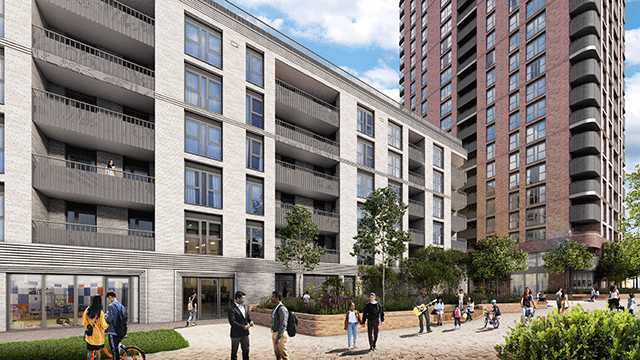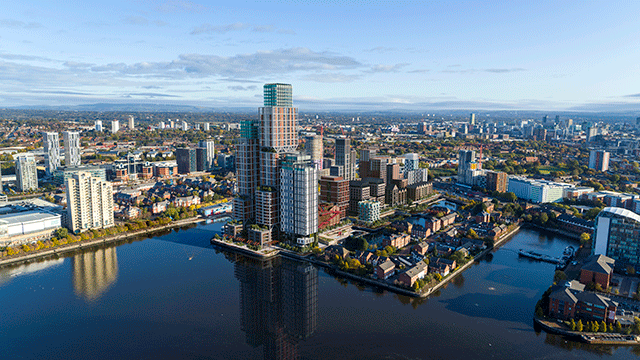As the UK stares down the barrel of one of the biggest housing crises in recent times, there has never been a more compelling case for investing in private rented housing.
Difficulties securing mortgages and the need for sizeable deposits are keeping people off the property ladder. The number of renters in England alone now stands at 4.4m, and this number is expected to grow to 5.7m by 2018, according to Savills. In London, for example, an individual now needs a deposit of £90,000 and a salary of £100,00 to buy an “average” house. With average salaries in the capital hovering around £27,000, it is clear to see that the rental market can only grow and grow.
The residential sector is the largest property asset class in the UK, valued at £4.2tn, with the PRS sector valued at £837bn. But according to Rebus Goodchild, international director at LaSalle Investment Management, speaking at EG’s Annual Residential Summit this week, institutions allocate just 4% (£18bn) of their property spending to residential. By comparison, they are the biggest investors in the £820bn commercial sector.
Nearly two years after Sir Adrian Montague’s blueprint for encouraging institutional investment into the PRS was published, there have been some significant developments.
The scale of interest in the government’s Build To Rent fund indicates growing momentum, with applications valued at £4.2bn received for a slice of the £1bn available, according to Knight Frank. The latest shortlist includes Spenhill Regeneration, Orbit Homes, Manchester city council, Development Securities and Grainger.
Nick Jopling, executive director, property, at Grainger, says: “The private rented sector is moving from being a quiet movement to a vociferous one. It requires more than one, two or three firms to create a marketplace, and that is happening now. There is enough activity that people are taking notice.”
Major international investors, including Ivanhoe Cambridge, Apollo Capital Management, Akelius, Qatari Diar, Abu Dhabi Investment Authority and APG have committed well over £1bn to the sector through UK partners since 2011. But why have many investors planned and subsequently failed to invest in PRS? And could that all be set to change?
Where’s the British money?
Just under 70% of the 39 key PRS transactions in 2012 and 2013 involved overseas funds. Some 53% of deals were driven by “old hands” such as Grainger and Dorrington, according to residential development consultancy Molior. But the investment was, by and large, foreign. So why haven’t we been confident enough to invest in our own stock?
Since 2009 there have been a number of examples of UK investors working up plans to put hundreds of millions of pounds into the UK’s PRS – to little avail. Aviva Investors, LaSalle Investment Management and Aegon Asset Management have all struggled to fund private rented homes on a significant scale.
Reputational risk has been a key factor for groups planning their debut or, for domestic fund managers such as M&G Real Estate, a return to the UK PRS. One fund manager adds that some investors blame a lack of suitable partners to team up with and the lack of a management platform.
One investor that eyed the UK PRS sector four years ago says: “It was too early to attract significant capital into the sector. There was nervousness about the housing market and uncertainty about the economy.”
But one of the biggest stumbling blocks has been the lack of fit-for-purpose built stock for investors to buy. They have faced a lot of leg work to build up portfolios of scale.
Bill Hughes, managing director at Legal & General Property, says: “One of the obstacles has been the absence of specifically designed build-to-rent assets. A significant amount of capital would invest in the finished product once it is fully income-producing. However, there is a scarcity of capital that behaves as a long-term investor but also has the appetite and skills to procure build-to-rent buildings through the land acquisition, planning, construction and letting phases.”
A major US investor adds: “You are buying £20m here and £15m there. It’s painstaking by the standards of many institutions, which just say: ‘Well, thank you very much, I want a £1bn portfolio, and if I can’t get that, I’m not going to do the work that is required to get that.’ I think many don’t have the boots on the ground. And people that do are often attracted to other asset classes.”
Overseas influx
None of this seems to have put off the international investors – though it is likely this is down to the fact that they already feel much more comfortable operating within the sector. Over the past 18 months, international investors including Akelius from Scandinavia and ADIA from Abu Dhabi have used their local expertise to get their foot in the door here in the UK.
The bulk of the commitment from the likes of Qatari Diar, ADIA, APG, M3 Capital Partners and Ivanhoe Cambridge has been concentrated in London and the South, where there is a significant capital growth opportunity.
Scott Hammond, managing director of Essential Living, says: “Overseas institutions have a strong track record of delivery and performance in this sector from investments in the ‘multi-family’ sector in the US. They understand the sector, and most of the indices and data matches that with the opportunity in the UK.”
Harry Downes, managing director at Fizzy Living – Thames Valley Housing Association’s private rental arm backed by ADIA – says: “Silver Arrow has PRS investments elsewhere, so it knew what to expect. It saw a huge supply and demand imbalance in the UK and believed that PRS was the solution. With international experience, Silver Arrow – an entity owned by ADIA – understood where we were coming from. Local institutions like UK PRS but many still believe it’s too risky.”
This might be true to a degree. But it seems the tide is finally turning. Whether domestic investors have been encouraged or shocked into action by the raft of funds being ploughed into the sector from overseas, it seems as though some are finally waking up to the potential in the PRS.
What changed?
“It’s a simple equation,” says Tom Henry, director and head of PRS investment at JLL. “More demand from occupiers and more support from government equals more investors. On the occupational side there has been a 75% increase in the number of PRS households over the past decade. The government has responded to this with Build to Rent to stimulate supply and institutions have recognised a huge potential asset class that is arguably the best inflation hedge in UK real estate.”
It helps too that, post-Montague Review, the government has now thrown its weight behind the sector and created a dedicated taskforce. It has identified more than £10bn that institutions would like to invest into the PRS.
There also appears to be cross-party political support to see greater institutional investment in rented housing in the run up to the General Election. The parties have distanced themselves from the threat of regulation in the sector – a factor that contributed to driving out UK pension funds previously.
At a more local level, the Greater London Authority has recognised the importance of providing new rented stock in its draft London Plan. It has set annual PRS targets for new homes and a rental covenant. it has set an annual goal of 5,000 new homes for rent within its 42,000-homes target. It has also outlined a rental covenant, agreeing a scheme must be rented rather than sold. It is also helping to drive the agenda by allocating certain public sector sites for PRS, such as agreeing to team up with Essential Living and Mace to develop Newington Butts in London’s Elephant & Castle, SE1, into 462 rented homes.
The push from policy makers has been matched by growing muscle across the industry. Firms including Savills, JLL, CBRE and Knight Frank have all strengthened their expertise in residential investment by growing teams dedicated in residential development. This growing professionalism is being matched by investors hiring people with residential skills dedicated to fulfilling PRS investment strategies too. And the IPD, through its UK annual residential property index, has helped to shine a light on the residential sector’s outperformance when pitted against inflation and commercial property.
John German, director of residential investments at Invesco Real Estate, says: “People have traditionally seen residential as an alternative rather than a mainstream investment. But with support from the likes of IPD, the BPF, the PRS taskforce, the Montague Review and IPF, UK PRS has started to be brought forward into the mainstream.”
The nuts and bolts
The scarcity of fit-for-purpose rented assets is driving investors to explore a range of formats in a bid to build portfolios. Most are investing in income-producing investments, forward purchasing stock, forward funding schemes and build-to-let development. The Urban Land Institute’s recently launched design guide is set to focus the industry further on designing homes for private rent rather than sale.
Alex Greaves, fund manager at M&G Real Estate, says: “Forward funding gives us access to stock where we can influence the design, efficiency, technology and service offer. We have forward funded a Build To Rent scheme through be:here for the M&G Secured Property Income Fund, with Poplar Harca, the housing association, taking a long lease. We will also forward fund and take direct let exposure.”
Invesco Real Estate’s German agrees: “The main strategy is backing the development of private rented stock because of the lack of institutional assets. It enables us to secure assets that are designed and built to fit demand. That is the big difference – getting a builder, contractor or developer who understands that. And they are starting to get it.
“We are not developers and we don’t intend to be. We are working on finding partners that can create product for us in a de-risked way. We will look at opportunities at the pre-build stage but don’t want the planning or construction risk. We accept we will probably pay more for that.”
The development of private rented homes is now supported through the national planning guidance too, with authorities being encouraged to recognise tenure through section 106 agreements.
Bruce Ritchie, chief executive of Residential Land, argues that comparative voids and management costs are now on a par with commercial property when dealing with rent-free periods, empty business rates and fee levels.
James Mannix, partner and head of residential capital markets at Knight Frank, adds: “Even Leeds, seen as a horror story of over-development during 2007 and 2008, has shown that it has a thriving city centre rental market dominated by young, economically active people.
“The income stream has demonstrated itself in the last downturn to be robust and to some extent counter-cyclical as the tenant body is swelled by individuals who would otherwise be purchasers.”
What next?
Despite such leaps forward, there is still some way to go before institutionally managed rental blocks are commonplace.
The lack of scale is arguably still the last major barrier to overcome. Around £11bn of capital is chasing up to £1.25bn of annually traded stock. And, with more than 30 new players in the market, there simply isn’t enough to go around, according to JLL. Investors have to get more comfortable with development risk.
“More time is needed to get parties comfortable with the proposition,” says James Coghill, Savill’s head of residential capital markets. “Investors are creeping up the development pipeline and we have seen significant development-related PRS deals. There remains a huge amount of capital that wants to invest in residential in the UK. We want to see the likes of Legal & General and M&G Real Estate do more direct investments in PRS as well as the long-income fund sale-and-leaseback structures.”
The government’s capital gains tax proposals threaten to unravel the effort that has gone into encouraging investors into the sector. Ritchie warns: “The government is in conflict with its policy of trying to promote investment to build homes. If you tax only residential construction then you will find fewer people putting money into residential and more people looking for commercial opportunities.
“It’s not about Kazakhstanis owning flats in One Hyde Park but institutional pension funds coming to invest in the UK for regeneration.”
Another major investor adds: “Tax could provide a chilling effect. Another risk is an exogenous event – a worldwide recession. They often ripple onto these shores and if they do and people can’t afford their rents, that could lead to price stabilisation or even a downward adjustment.”
The Help To Buy scheme, newly extended to 2020, which is helping people get on the housing ladder, is expected to temper the pace of growth in the PRS. And competition with housebuilders for land in some parts of the country is pushing up land values, making PRS bids unviable.
Downes says: “PRS landlords have extra costs to factor in when evaluating the potential purchase of a site for rent, such as the costs of a building manager, 24-hour helpline, lifecycle costs, planned maintenance and insurance policies. It is a very difficult model to make work when competing with housebuilders and developers, which plan to sell the homes rather than rent them.
“No PRS landlords can compete [buying sites] in the sales market unless there are special beneficial conditions. However, it becomes possible if you can get a long-term PRS allocation through a section 106 commitment as it will bring down the residual value of the land. While planning is getting easier, it will continue to be hard to develop homes for rent until it is more widespread [and more widely accepted by local authorities] through section 106 provisions. A lot hinges on the planning regime.”
There are calls for the government to strengthen advice to local authorities to be more flexible to make PRS deliverable through planning. Some argue for a separate planning class to help the sector flourish.
Willmott Dixon Regeneration, which has a PRS business through be:here, has asked the government to focus on two key areas. The first is to create a new planning class for newly created PRS homes. The second is to designate publicly owned land available for PRS development and act as a catalyst for the sector.
“The two big elephants in the room in terms of challenges outstanding for the sector are valuation and planning. The valuation methodology for PRS must shift away from a discount to vacant possession value toward one more akin to the commercial market, recognising the asset’s net operating income,” Jopling says.
“As for planning, it is critical that the planning system and local planners recognise the very different business models between building homes for sale and building homes for rent. The economics are completely different and they cater for different parts of society.”
annabel.dixon@estatesgazette.com
• Kris Hopkins: the man to tackle the housing crisis
• Finally, lift off for PRS – but where are the UK investors?











